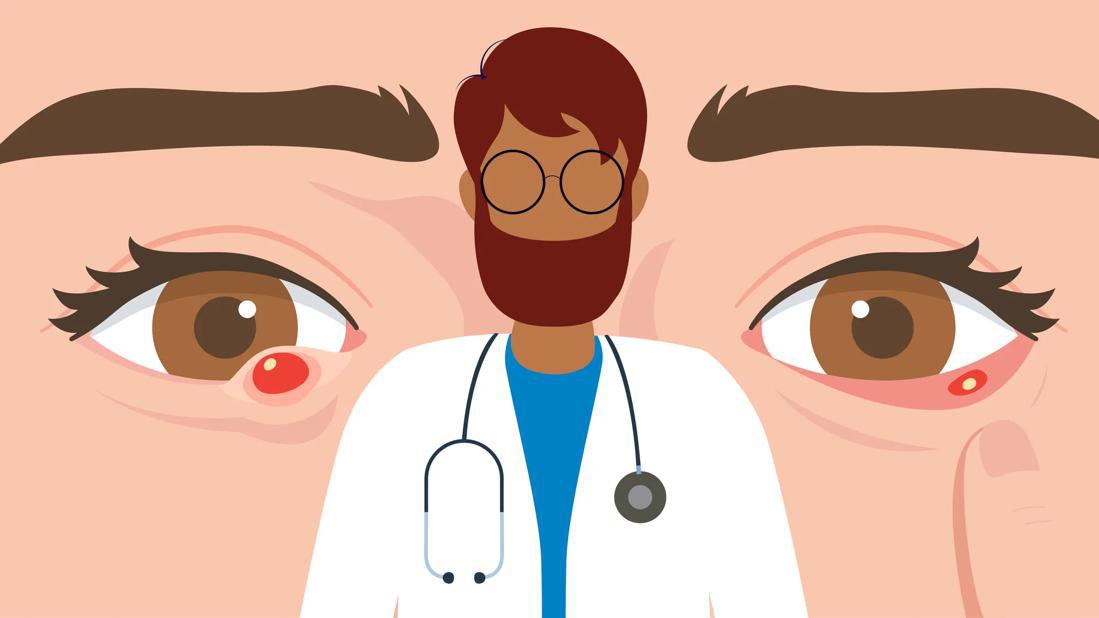Chalazion vs. Stye: What’s That Bump on Your Eye?
Both chalazia and styes appear as bumps on your eyelid — but styes are typically painful

Ever wake up to a little red bump on your eye and wonder what that’s all about?
Is it a stye? Or a chalazion? And what do you do about it?
We asked Justine Filippelli, PA-C, a physician assistant in ophthalmology, about the similarities and differences.
Chalazion vs. stye
Both chalazia (the plural of chalazion) and styes are raised bumps that appear when the oil glands on your eyelids get blocked. Chalazia pop up when those glands get irritated and inflamed. Styes happen when a localized bacterial infection takes hold.
“A stye happens when your oil glands lash follicles are infected. Chalazia are non-infected clogged oil glands, which causes inflammation and a hardened bump,” Filippelli explains.
Neither chalazia nor styes are contagious. You can’t spread them to someone else. And you can’t catch them from another person. But it’s still important to practice good hand hygiene and avoid sharing towels or makeup to prevent bacterial spread.
How to tell the difference between a chalazion and a stye
Knowing what’s causing a red bump on your eye is the first step to getting proper treatment. Here’s how to tell the difference between a chalazion and a stye.
Chalazion
- These usually appear farther back on your eyelid, away from your eyelashes. They can happen either on your top or bottom lid and either on the inside or outside of your eyelid.
- They may be sore or tender initially but not painful. “Chalazia aren’t painful to the point where you can’t open your eye or that they affect your vision. But that bump can cause pressure and some discomfort. But it’s usually tolerable,” Filippelli clarifies.
- They can last for months.
Stye
- These usually show up near your lash line. That can be either on your top or bottom eyelid. They can occur either on the outside of your eyelid (external stye) or the inside (internal stye).
- They may be painful.
- They tend to go away on their own within a week or two.
Styes and chalazia can also happen at the same time.
“It’s common that when your lash follicle gets infected, and you get a stye, the oil gland may also be affected. So, after the stye clears up, you may be left with this hard, tender bump — a chalazion,” Filippelli explains.
Is a chalazion worse than a stye?
So, here’s what you may be wondering, Which is the “bad” one? Is it worse to have a chalazion or a stye?
Take heart that neither is life-threatening. And in the vast majority of cases, they’re nothing more than a relatively minor inconvenience.
But if they’re very painful, accompanied by other symptoms or aren’t clearing up on their own, both chalazia and styes are worth seeking medical attention.
“A stye can be an acute infection, and there’s potential that the infection can spread around the eye and behind the eye and cause orbital cellulitis and permanently affect your vision,” Filippelli reports. “It’s extremely rare. But it’s a good reason to seek treatment if you’re dealing with a particularly angry stye.”
Getting a chalazion checked out can also be important, especially if it lasts more than a few weeks. That's because you don’t want to brush off a lump on your eye (or anywhere for that matter).
“It’s happened in my career where people have been seen or treated for a stye or chalazion, but the treatment hasn’t worked. And when we take a biopsy, we see that it wasn’t the right diagnosis and it turned out to be skin cancer. This is a very rare occurrence,” she notes.
How to get rid of a chalazion vs. a stye
Both chalazia and styes can often be treated at home, but some may benefit from a visit to a healthcare professional. Here’s what to try.
Chalazion
- Try warm compresses a few times a day.
- A very gentle eyelid massage might help. “Wash your hands well and use a bit of baby shampoo diluted with water or specialized eyelid wash. Lightly massage on the chalazion for 10 to 15 seconds. That can help to break up the oil and it should start to shrink,” Filippelli instructs.
- Avoid eye makeup while you have a chalazion.
- Don’t try to squeeze or pop it.
Be patient. A chalazion can last for several weeks. But if those measures don’t do the trick after several weeks or months, it’s time to see a healthcare provider. They may recommend an office procedure to drain it.
Stye
- Cover with a warm compress a few times a day. Run a washcloth under warm water, ring it out and hold it to your eye for several minutes. “That can help to move any oil that may be getting clogged and help it shrink,” Filippelli advises.
- Try some over-the-counter medications, like acetaminophen (Tylenol®) or ibuprofen (Advil®) to help with pain.
- Avoid wearing eye makeup.
- Don’t wear contact lenses.
- Don’t touch or pop it. That can spread infection and damage your eye.
If the stye isn’t responding to these methods after a few days, it might be time to talk with a healthcare provider about antibiotics — either as medication you take by mouth or antibiotic eye drops.
If that doesn’t do the trick, your provider may recommend an office procedure to drain the oil.